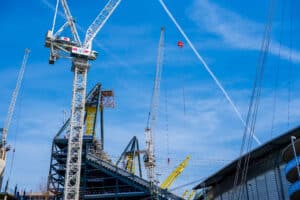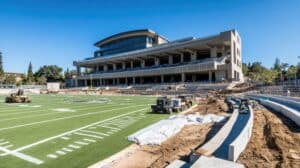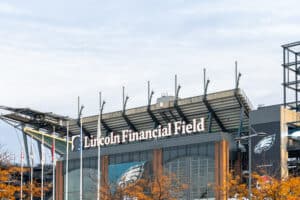

When you’re watching football, what comes to your mind? Is it grabbing a beer, seeing the Birds in Super Bowl LX, or how much you despise the Cowboys? Well, if you’re an engineer, chances are your mind might go to a slightly different place. Football stadiums, aside from being the hubs for our favorite teams to play, are a complex and fascinating web of civil and structural engineering decisions that blend so seamlessly that it’s easy to take all of it for granted. To help fans appreciate the extensive planning that goes into making game day a success, let’s break down just a few of the key considerations behind the design of stadiums.
Site Selection and Preparation
Before a single beam is erected, engineers must evaluate the ground beneath. Geotechnical surveys assess soil stability, groundwater levels, and seismic risks to ensure the site can support the massive loads of a stadium. Accessibility is equally critical—proximity to highways, public transit, and utility infrastructure can make or break a stadium’s success.

Structural Design Considerations
Stadiums must endure a wide range of loads. Dead loads include the weight of the structure itself, while live loads account for thousands of fans, equipment, and temporary installations. Dynamic loads—from wind, seismic activity, and even the vibrations of cheering crowds—require advanced modeling and resilient design.The material used in construction plays a critical role in carrying these loads. Steel offers flexibility and strength for long spans, while reinforced concrete provides durability and cost-efficiency.
Long with this, the type of foundation varies depending on different considerations as well. Large stadiums often require deep foundations, but in areas with firm, uniform ground, a shallow foundation may suffice. It’s all up to the engineers to determine the best plan of action based on the environment and geography.
Structural Integration
If you’ve ever wondered why all stadiums are shaped like that—you know, the iconic bowl shape—you’re about to get your answer. It’s not just aesthetic, it’s a feat of engineering. Tiered seating allows all guests to have clear sightlines while maintaining structural integrity. Designs that incorporate beams supported at only one end (known as cantilevered in the engineering world) allow unobstructed views without columns, enhancing the fan experience.
The roofing systems are another marvel in and of themselves. Retractable roofs offer flexibility for weather and event types, while fixed roofs rely on long-span trusses and tension structures to cover vast areas without internal supports disrupting the playing field below.
Safety and Code Compliance
Safety is paramount. Stadiums must include clear evacuation routes, fire-resistant materials, and adhere to regional building codes. For example, engineers must ensure that every stadium is ADA-compliant, incorporating ramps and accessibility points for individuals with disabilities.
Engineers must also plan to consider the flow of foot traffic through the stadium, integrating crowd control measures into designs. For example, the location of concession stands is carefully planned to avoid creating choke points for people standing in line and traffic in the concourse. Even the number of bathrooms for each gender is carefully considered, planned, and incorporated into the design.
Case Study: Lincoln Financial Field
Philadelphia’s Lincoln Financial Field exemplifies these engineering principles. Built on a carefully selected site with robust infrastructure access, it features deep foundations and a steel-framed bowl design. Its cantilevered seating tiers and open sightlines reflect meticulous planning. Fans rarely consider the seismic modeling, wind load calculations, or material testing that went into its construction—but these elements are what make the experience seamless and safe.
Building Beyond Game Day
From soil surveys to structural trusses, every detail is a testament to the ingenuity of civil and structural en
gineers. As fans cheer from the stands, they’re supported by a silent framework of precision and resilience—one that makes the magic of game day possible. So, the next time you get to cheer on your favorite team, in person or on TV, you can thank an engineer. If you’re still curious and want to learn about the projects that Carroll Engineering is working on in your community, please visit our new Featured Projects page.


